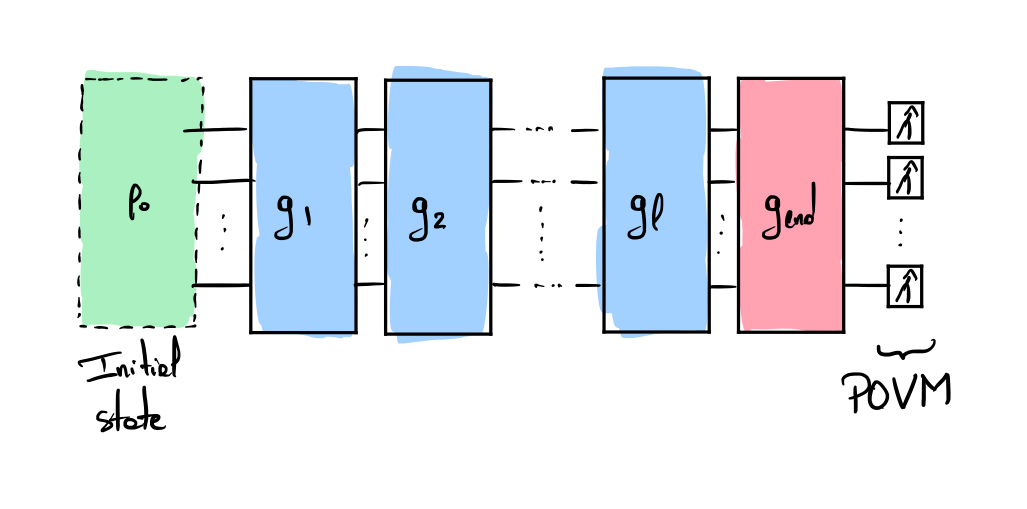Randomized Benchmarking (RB) Protocols
Classification of RB protocols
Randomized Benchmarking (RB) protocols evaluate the ability of the quantum computer to reliably perform quantum operations. This tool is used to provide bounds on the error rate of quantum gates. The global idea is to use varied-length random quantum circuit based on a specific gate set to quantify the average error rate of the gate set. The length is denoted \(l\) and varied with different values \(l \in \{l_1, l_2, ..., l_k\}\). The random circuits are built in a way that the measurement of the qubit yield a deterministic output bitstring. If the bitstring is measured, the computation is considered a success, otherwise, a failure. The average probability of sucess is extracted for each circuit length \(l\) and is used to fit an exponential decay function of the sucess probability:
\[p_\mathrm{success}(l) = A \alpha^l + B\]where \(A\), \(B\) and \(\alpha\) are the fit parameters. The states prepartion and measurement errors are absorbed in the coefficients \(A\) and \(B\). In this fit, \(\alpha\) is related to the average error rate by \(r = 1 - \alpha - (1-\alpha)/d\) where \(d = 2^n\) is the size of the Hilbert space.
Following the classification done by J. Helsen et al. [1], a randomized benchmarking experiment is composed of the following key components:
- \(\mathbb{G}\): A group of gates which are applied during the RB protocol. The \(l\) gates composing the sequence are drawn from this group. This group is a subgroup of the unitary group (e.g. Clifford group).
- \(\{l_1, l_2, ..., l_k\}\): A set of sequence lengths that denote the length of the random sequence of gates. These lengths are used to fit the exponential decay function.
- \(\phi_r\): A reference implementation \(\phi_r\) mapping each gate \(g \in \mathbb{G}\) to its ideal implementation. The decomposition of this single gate to elementary gates used by the quantum computer should be specified.
- \(\nu\): A probability distribution (or a set of probability distribution) \(\nu\) defining how each gate \(g\) is selected from the group \(\mathbb{G}\). In almost all cases, this distribution is a uniform distribution.
- \(g_{end}\): An ending gate. It is usually used to revert the action of the sequence of gate over the initial state. In this case, the success bitstring is the initial state.
- \(\rho_0\): An input state. In many cases, the input state is just the pure state \(\ket{000...0}\).
- \(\{\Pi_i\}_{i \in \mathcal{I}}\): A Positive Operator Value Measure (generalization of the projective measurement).
A generic quantum circuit can be drawn from these specifications with the initial gate \(\rho_0\) followed by the \(l\) sequences of gates and the POVM:

The fitting of the exponential function is based on the assumption that:
- The noise is both time and gate independent
- The noise is Markovian (assumption done in almost all RB protocols), i.e., the noise does not depend on previous gates operations.
The reader can refer to the references [2], [1] for a high overview over the different RB protocols. The reader may also refer to the gentle introduction on RB in [3].
List of RB protocols
- Clifford Randomized Benchmarking
- Other gate set Randomized Benchmarking
- Randomized Benchmarking for cross talk errors
- Error Per Layered Gate (EPLG)
References
- [1]J. Helsen, I. Roth, E. Onorati, A. H. Werner, and J. Eisert, “General Framework for Randomized Benchmarking,” PRX Quantum, vol. 3, no. 2, p. 020357, Jun. 2022, doi: 10.1103/PRXQuantum.3.020357. [Online]. Available at: https://link.aps.org/doi/10.1103/PRXQuantum.3.020357
- [2]A. Hashim et al., “A Practical Introduction to Benchmarking and Characterization of Quantum Computers.” arXiv, 2024 [Online]. Available at: https://arxiv.org/abs/2408.12064
- [3]A. Silva and E. Greplova, “Hands-on Introduction to Randomized Benchmarking,” arXiv preprint arXiv:2410.08683, 2024.
- [4]J. Emerson, R. Alicki, and K. Życzkowski, “Scalable noise estimation with random unitary operators,” Journal of Optics B: Quantum and Semiclassical Optics, vol. 7, no. 10, p. S347, 2005.
- [5]C. Dankert, R. Cleve, J. Emerson, and E. Livine, “Exact and approximate unitary 2-designs and their application to fidelity estimation,” Physical Review A—Atomic, Molecular, and Optical Physics, vol. 80, no. 1, p. 012304, 2009.
